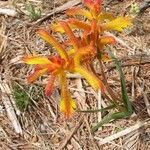A clumping plant which keeps growing from year to year. The rhizome is thick. It grows 30-60 cm tall. The leaves are 1 m long by 2-4 m wide. There is a sheath at the base. The flower stems are 2 m high. They are branched. The flowers are like tubes and 3-4 cm long. They are covered with hairs. The flowers are yellow-green but can be red or pink.

